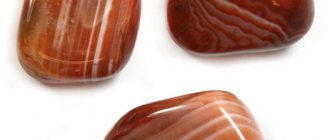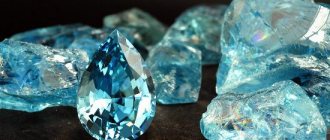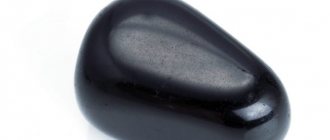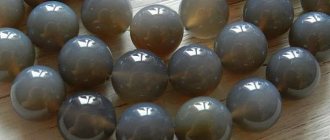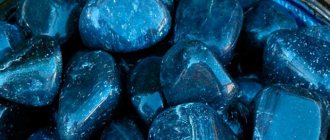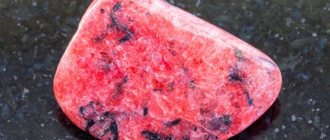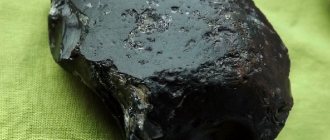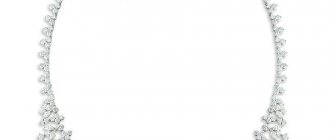Lapis lazuli
— Na6Ca2(AlSiO4)6(SO4,S,Cl)2 is an opaque mineral from blue to bluish-gray or greenish-gray; the best stones are juicy blue or blue-violet, as well as deep blue. Lapis lazuli is a sodium-calcium aluminosilicate of bright blue, violet-blue or greenish-blue color. Such shades are due to the presence of sulfur ions. Individual lapis lazuli crystals are very rare; their size does not exceed a pea.
- Structure
- Properties
- Morphology
- Origin
- Application
- Classification
- Physical properties
- Optical properties
- Crystallographic properties
See also:
Lapis lazuli
- price and medicinal, magical properties
Physical properties and structure of diamond
History and origin
The history of the stone begins in Badakhshan, an area on the border of Tajikistan and Afghanistan, now under the rule of the latter. It was there that about three thousand years ago they began to mine amazing blue stones - opaque, silky shine, some of them were dotted with golden veins. The color of the stone varied from greenish-blue to purple.
Uncut lapis lazuli
Lapis lazuli stones were found in blocks of marble mined in Badakhshan - the main building material for temples and palaces of antiquity. The inclusions of bright blue mineral immediately attracted the attention of local emirs. It was declared the greatest value; the slaves who mined it were chained to the walls of the mines in order to avoid escaping with a block of stone. And now the mining of Badakhshan lapis lazuli is one of the main sources of income for the Afghan Taliban movement.
Lapis lazuli was used for interior and exterior decoration of walls and ceilings of temple and palace complexes. In the East, he was firmly identified with Heaven. From Afghanistan he came to Persia, from there to Egypt, ancient Hellas and Rome, and thus ended up in Europe.
Now lapis lazuli is an ornamental stone of the first order according to the Bauer-Fersman classification. At the same price level are, for example, jade, amazonite, azurite, agate, vesuvian and jasper.
Lapis lazuli is similar in appearance and name to azurite - a blue opaque mineral of a similar texture. It differs from azurite in its chemical composition (lapis lazuli contains sulfur), higher hardness and the absence of play and color transitions.
In the states of Central Asia and China, lapis lazuli was a symbol of royal power and at the same time of Heaven, that which extends over everyone, be it an emir, a mandarin, a warrior or a peasant. In Egypt, lapis lazuli stones were given a connection with Amun-Ra, the main god of the later dynasties of the pharaohs. Products with lapis lazuli were found in the burial chambers of many pharaohs, for example, Tutankhamun.
Lapis lazuli in different shades
The meaning of the stone, according to the ideas of the ancient Egyptians, is judicial power, the highest divine justice. The badge of an Egyptian judge was a lapis lazuli breastplate with the hieroglyph “Truth.”
It was from Afghan lapis lazuli that the boards were made on which Moses wrote down the commandments sent down from above.
A description of the stone will be incomplete without mentioning that it has long been used by artists of both the West and the East to make bright blue paint - ultramarine. The natural mineral was used in the form of a fine powder and was most suitable for making paints based on water, resin and tempera.
The Latin name of the stone is “lapis lazuli”, which is what it was called throughout Europe, including Russia, until the 18th century. It goes back to the Persian “lazhvard”, which means “heavenly stone”. In Rus', this mineral has been known since approximately the era of Ivan the Terrible. In Russian, he received the nickname “lazorevik” or “lazurik”.
The magical properties of heavenly lapis lazuli
Lapis lazuli stone has the power of purification. With the help of a personal talisman, you can clear your mind of resentment, uncertainty, anxiety and other unpleasant feelings. The mineral also has the ability to cleanse the aura and consciousness of its owner.
Lapis lazuli, magical properties of natural crystal:
- helps to carry out a life “reboot”. Gets rid of anchors that inhibit development in the form of uncertainty, old grievances or fears;
- helps to improve relationships between spouses, relatives, and colleagues;
- helps to find inner balance, find spiritual harmony and peace;
- adds self-confidence, which contributes to increased human activity;
- adds courage and responsibility in making vital decisions;
- maintains a clean and bright mind in stressful situations;
- prevents you from making wrong decisions and making fatal mistakes;
- protects against the evil eye, the bad influence of others and becoming dependent on other people;
- fills life with kindness, tenderness, love and care;
- protects from unkind thoughts, depression and self-flagellation;
- enhances a person’s intuition and hidden abilities;
- reveals creative potential;
- hides from slander, gossip or evil words.
Since ancient times, the stone lapis lazuli has personified sincerity, kindness, and honesty. Many peoples attributed to him the ability to establish connections with the other world. Thanks to this effect, natural crystal was often used to decorate the clothes and attributes of magic of priests, shamans and magicians. It is believed that lapis lazuli helps to establish relationships between a person and his guardian angel.
Jewelry made from natural lapis lazuli are also powerful talismans that can change lives for the better.
If you want to bring prosperity, happiness and love into your home, buy an interior decoration or souvenir made from lapis.
The divine stone lapis lazuli reveals the best qualities in a person: the ability to love, care for loved ones, remain faithful and prudence.
There are not only blue lapis lazuli; crystals of other colors are also found in nature. Each color stone has its own power.
- Purple lapis lazuli is aimed at working with the human psyche and consciousness. A purple stone is suitable for scientists, researchers and psychologists. Helps determine the opponent’s personal qualities. Helps investigators, confessors and teachers in their work.
In Feng Shui, lapis lazuli is used to cleanse a room of negative energies. To protect and cleanse the room, use products and figurines made of natural stone.
It is important. Lapis lazuli encased in gold enhances intuition and influences the development of character traits. Jewelry made in silver protects against negative energy, cleanses the aura, and resists black magic.
Physicochemical characteristics
Characteristics: lapis lazuli is a complex compound of aluminum, sodium, silicon, sulfur and oxygen. The composition may contain calcium, individual inclusions of feldspars and pyrite. Belongs to the subclass of frame aluminosilicates. A rock-forming igneous material released from magma very low in silica.
Blue lapis lazuli
Hardness 5.5. Can be scratched with a knife made of alloy or carbon steel. Doesn't scratch glass.
The rich blue color of lapis lazuli is due to the presence of sulfur in its composition, which partially replaces silicon. Sulfur content - up to 0.7%. The higher it is, the thicker and brighter the color.
Lapis lazuli crystal is a rare occurrence. The usual form of its occurrence in nature is veins in marble or massive blocks. In turn, lapis lazuli can have golden veins, which in ancient times were considered true gold. But this is pyrite, also known as sulfur pyrite, iron disulfide. The blue tit is not a gemstone.
The properties of lapis lazuli make it easy to process, but also easy to damage.
| Formula | Na[(AlSiO4)SO4] |
| Color | Shades of blue |
| Shine | Glass |
| Transparency | Translucent |
| Hardness | 5,5 |
| Cleavage | Implicit |
| Kink | Conchoidal, granular |
| Density | 2.38 - 2.42 g/cm³ |
Chemical and physical properties of lapis lazuli
This mineral belongs to the group of silicates and its composition is described by the following chemical formula: Na6Ca2(AlSiO4)6(SO4,S,Cl)2.
The color of lapis lazuli varies from sky blue to deep purple and depends on the amount of sulfur anions present in the mineral. Lapis lazuli can be dissolved in hydrochloric acid and the process is accompanied by the release of hydrogen sulfide.
Advertising - Continued below
Sometimes the mined minerals contain inclusions of golden or silvery pyrite. Lapis lazuli is classified as an ornamental stone. Most often, the stone is processed in the form of a cabochon or plate. In addition, elegant figurines and boxes are not uncommon, transformed thanks to the amazing texture and pattern of the stone.
Mining areas
The oldest deposit, which is still being developed, is in the province of Badakhshan, near the Tajik border (northern Afghanistan). At the beginning of the 20th century, the mineral was discovered in the mountains of the nearby Pamirs.
On the territory of Russia, deposits of lapis lazuli were discovered in the 18th century in the Southern Baikal region, on the banks of the Slyudyanka River. The initiator of the search was Empress Catherine II.
Less significant deposits are located in Chile (Andes Mountains), China and certain areas of Africa.
Varieties and colors
Blue tit comes in different shades - blue, deep blue, with a hint of green, lilac-violet. It can be uniform, have golden veins; in cheap varieties, white and gray inclusions of feldspars are acceptable. The inclusions may look like blots of canvases or, less commonly, “eyes.”
The highest cost is for Afghan lapis lazuli. Afghans distinguish three main types of their national stone:
- neither - deep blue, uniform or with gold veins;
Niili - Asmani - blue or light blue, the color of the sky;
Asmani lapis lazuli - sufsi - greenish, interspersed with low-value stones.
Sufsi
The highest price is the price; after processing (polishing, cutting, inserting into a product), it can reach $10 per gram, depending on the beauty of the stone. The sufsi is valued lowest.
The Baikal blue tit roughly corresponds to the Afghan blue tit in color scheme. Pamir and Chilean are paler.
Lapis lazuli deposits
The richest deposits of this mineral are located in Afghanistan. The most valuable specimens of lapis lazuli are mined in Badakhshan. Stones from the Baikal region are valued equally with them. Lapis lazuli mines are also located in other countries: China, Chile, Tajikistan, India and Africa.
Advertising - Continued below
In Afghanistan, mined lapis lazuli is divided into three types.
- Sufsi is the least valuable stone with a greenish tint.
- Asmani is a common sky-colored lapis lazuli.
- Niili is the most expensive purple lapis lazuli.
If a rock consists of more than 40% of this mineral, then it is called lapis lazuli.
Benefits for the body
The healing properties of lapis lazuli are associated with its energy - projective (yang). This is a classic “masculine” stone - the sign of gender in this case refers not to the rules of wearing, but to the magical property of the stone to actively influence the world around it. Talismans and amulets made from blue tit change the world, not their owner.
Gold bracelet with lapis lazuli
The main medicinal properties of lapis lazuli include, first of all, the correction of the functions of the endocrine system as a whole. It restores the thyroid gland, improves blood pressure and the circulatory system. Useful for skin diseases.
The use of the stone has a more powerful effect if you use acupressure products - rollers, balls and other similar objects made of natural mineral.
If you use it in a ring on your left hand, the stone will be able to cleanse the lymph and soothe inflamed lymph nodes. A large specimen of rich blue color is invaluable for meditation - if you look at it for a long time, you can get rid of a state of anger, unmotivated fear, relieve exaltation or ecstasy, and improve well-being in case of prolonged depression. The blue tit is also useful for various ophthalmological diseases.
Since the times of Ancient Egypt, lapis lazuli powder has been used to treat poisoning or, in particular, excessive vomiting for no reason.
A wide lapis lazuli bracelet on the right hand reduces the frequency of asthma attacks. And lapis lazuli beads make pregnancy easier and reduce the likelihood of miscarriage in women.
Healing properties
Healing influences of lapis lazuli on the human body have been discovered by healers since the discovery of the nugget. The stone, crushed into powder, was used as an antidote or for any other poisoning accompanied by vomiting. This medicine also served as a remedy against parasites.
In medieval Europe, lapis lazuli was used as a means of gaining weight in case of exhaustion of the body. And in the East, the lapis lazuli talisman was worn in the harems of the wives of sultans who were expecting a child. There was a belief that such an amulet would help carry and give birth to a healthy baby.
Modern lithotherapists also use lapis lazuli for medicinal purposes. Experts note the healing capabilities of the stone in the field of ophthalmology. If you contemplate a nugget several times for five minutes every day, your visual acuity returns.
In addition, this kind of meditation improves a person’s emotional state, helps to get out of a depressive state, cope with fears, nervous disorders, and improve sleep. A bright blue stone is suitable for these purposes. The mineral inserted into the necklace will have a positive effect.
This is interesting! Trichologists have discovered the amazing effect of the mineral on hair. According to experts, lapis lazuli earrings help the fair sex improve the condition of their hair and increase its volume.
Lapis lazuli has a positive effect on the body's endocrine system, restoring the functioning of the thyroid gland. In addition, the mineral normalizes blood pressure and acts as a blood purifier, therefore it is used to stop bleeding and heal wounds. The rich blue mineral copes with ulcers of any origin - stomach, skin, intestinal.
Wearing a gem is useful for people with respiratory problems, including swelling of the larynx due to allergies. A pendant or brooch with lapis lazuli helps with bronchial asthma, as well as radiculitis. It is better if such a stone is set in silver.
It is also useful for asthmatics to wear a lapis lazuli bracelet on their right hand. To cleanse the lymph and stop the inflammatory process in the lymph nodes, it is recommended to wear a ring with lapis lazuli on your left hand. And nugget beads act as a talisman for pregnant women, ensuring the normal course of pregnancy and protecting women from premature birth or miscarriages.
Magic abilities
According to its magical properties, lapis lazuli is classified as the dominant planet Jupiter. The Romans considered it the stone of their supreme god, after whom the planet was named (in the Hellenic tradition it is Zeus).
Magic believes that the main properties of lapis lazuli are cleansing the mind from unnecessary feelings, unnecessary emotions, and extraneous thoughts. The stone imparts composure and calmness, facilitates thinking, although it somewhat reduces the speed of reactions. Among those for whom lapis lazuli is optimally suited are theoretical scientists of all sciences, priests (regardless of religion), writers, lawyers and jurists (in those moments when you need to sit, think and isolate the main thing from the matter).
But he has negative compatibility with any business people - drivers, rescuers, athletes, active duty military, industrial workers where speed and accuracy of reactions are required.
Lapis lazuli calms, relaxes, and induces a meditative state, so it is not recommended for constant wear in the modern world. But it enhances intuition and attracts the views of others, including people of the opposite sex, to its owner.
Amulets and talismans made of lapis lazuli have been considered symbols of sincerity and friendliness since ancient times. They influenced not so much their bearer as those who had the intention of lying to him or causing harm in another way, gradually turning him away from this idea.
A stone set in gold attracts good luck and the attention of people of the opposite sex. Silver - serves as protection against dark forces.
Lapis lazuli and the signs of the Zodiac
The energy of the stone from the zodiac signs is suitable for Aquarius, Libra, Pisces, Aries. They can use the mineral at any time.
Lapis lazuli endows the Sagittarius zodiac sign with intuition, smoothes out inconstancy in friendship, protects from harmful influences, and sharpens the mind. Suitable for Libra, less useful for Leos and Scorpios.
They may use lapis lazuli as an amulet or talisman on occasion. Constant interaction is not advisable. Cancer or Capricorn - this is the zodiac sign that is better not to experiment with the mineral.
The stone has the ability to bring peace, eliminate depression, and reduce tension. This is especially valuable in our crazy times, so it’s worth purchasing raw or polished lapis lazuli for your home or office. Everyone can afford it.
Zodiac compatibility
Astrologers strongly associate lapis lazuli according to the zodiac sign with Sagittarius. This is an ideal jewelry stone for the most hot-tempered, fickle and restless Fire sign, despite the fact that it belongs to the Earth minerals. Lapis lazuli jewelry can be worn by Aries, Pisces, and Aquarius. According to the horoscope, he is suitable for Libra.
But for representatives of the most “powerful” fire sign - Leo, and the most unpredictable and out-of-the-box thinker - Scorpio - the blue tit is contraindicated.
| Zodiac sign | Compatibility |
| Aries | + |
| Taurus | + |
| Twins | + |
| Cancer | + |
| a lion | + |
| Virgo | + |
| Scales | +++ |
| Scorpion | + |
| Sagittarius | + |
| Capricorn | — |
| Aquarius | + |
| Fish | + |
(“+++” – fits perfectly, “+” – can be worn, “-” – is strictly contraindicated)
Price
Lapis lazuli is considered a semi-precious or ornamental stone. The price is determined in grams, not carats, and does not exceed $2 per gram (or $0.4 per carat). The best samples are used as jewelry. Gems, rings, pendants, earrings with inserts are cut from them, and sets are assembled. The mineral is cut into a cabochon and placed in a gold or silver frame. Inexpensive mass-produced beads cost $10–20.
We recommend reading: Petersite (Hawk Eye) - a stone of spiritual harmony
Jewelry made by the author in a single copy is valued higher than products with a first-row gemstone.
Compatibility with other stones
Lapis lazuli is one of the classic stones of the Earth. Other earthly rocks are jasper, jade, agates and chalcedony of all types and varieties, crocodile, malachite, turquoise, labradorite and morion. All these are opaque stones. Lapis lazuli is compatible with any of them.
Bracelet with lapis lazuli
A good combination is a company with Water gems:
- emerald;
- precious opal (except black);
- aquamarine;
- topaz;
- pearls;
- goshenite;
- peridot;
- euclase.
It is strictly unacceptable to combine with Fire - almandine, pyrope, grossular, all types of garnet, except demantoid and uvarovite. Particular attention should be paid to ensure that lapis lazuli does not fall into a ]diamond[/anchor] or ruby - they will “destroy” it.
The combination with Air - the mentioned demantoid and uvarovite, rock crystal and other clear quartz, rauchtopaz, golden beryl, amazonite, amethyst and chrysoprase - is neutral.
Place of Birth
The mineral is formed when magma penetrates sedimentary or metamorphic rocks. This interaction creates the appearance of the stone. The most famous, described seven centuries ago by the famous Marco Polo, are the Afghan mines. They have not been depleted even today; the stones of the lapis lazuli family from the Badakhshan mountains are the best in the world. Newly discovered deposits of another hemisphere - the Chilean Andes - compete with them in quality.
We recommend reading: “Royal” Demantoid - a diamond-like stone
Application area
It is an ornamental mineral, which is mainly used for making sculptures, figurines and other stone-cutting products. Plates and sections of lapis lazuli are used in mosaic work, for cladding walls and columns. There are known large statues and columns made from single blocks of blue tit, for example, the colonnade of St. Isaac's Cathedral.
Beads with lapis lazuli
Nowadays, gold and silver jewelry with lapis lazuli are rare due to the difference in the price of these metals and the stone itself - it is no longer considered expensive. Although some workshops make personal silver and gold jewelry and decorative items from it, mainly for connoisseurs. This practice is more common in the East.
Lapis lazuli beads of various shapes are sold on the market for home craft items and for the needs of hand-makers.
MORPHOLOGY
Crystals are rare, most often represented by rhombic dodecahedrons, rarely cubic and octahedral. Usually found in continuous dense masses, in the form of fine-grained aggregates, forming veins. Often lapis lazuli is also called a heterogeneous blue-blue polymineral rock formed by the dense intergrowth of grains of lapis lazuli, sodalite, dolomite, calcite and other minerals. Lapis lazuli is valued for the beauty of its enchanting blue color, which comes in a wide range of shades. The color of the stone varies from soft turquoise to bright blue and purple. To the naked eye, the stone may appear entirely blue, sometimes it is white with blue stripes, and often contains inclusions of small grains of irregularly shaped pyrite. There are three main varieties of lapis lazuli:
- Niili is an indigo blue stone that has the greatest value;
- Asmani is a stone of lesser value, having a sky blue color;
- Fursi is an inexpensive greenish-blue stone.
Dark indigo-blue lapis lazuli stones that do not have visible light inclusions are most valued. Dark blue stones with a violet tint, interspersed with pyrite, sparkling with gold and silver tints are also highly valued. All other varieties of lapis lazuli are used in the manufacture of costume jewelry, cladding, figurines and tableware. The deposit has a great influence on the color of lapis lazuli. Thus, Afghan lapis lazuli shines with golden sparkles of pyrite inclusions. Baikal lapis lazuli is blue in different shades with white spots and stripes intertwined into beautiful patterns. The color of the stone also depends on the presence of sulfur. In sunlight, lapis lazuli is bright and sparkling; in electric light, it is dark and dull. In ultraviolet rays, lapis lazuli sometimes luminesces with a faint orange light.
How to recognize a fake
Artificially grown minerals that imitate lapis lazuli are rarely found on the market. Basically, colored low-value varieties of lapis lazuli or stones of a different nature - cacholong, jasper, chalcedony - are passed off as high-quality stones. Painted “lapis lazuli” glass is also available.
The main way to identify a fake at home is to dip a stone in water. On the imitation, the liquid will collect in small drops, while the natural stone will remain evenly moist. In addition, a true blue tit looks brightest in sunlight, but dims in twilight or electric light.
How to distinguish fake lapis lazuli from natural one
Dumortierite, sodalite and colored lapis lazuli are used as counterfeit jewelry.
Fake lapis lazuli - dumortierite, fake lapis lazuli - sodalite, imitation lapis lazuli from polymer clay
The natural mineral can be distinguished from dumortierite by its silvery sparkles on the surface and glassy sheen: dumortierite has neither of these, and its color is rather dull. In addition, natural lapis lazuli is significantly more expensive than such a fake.
Advertising - Continued below
Sodalite differs from natural lapis lazuli in its transparency. If you look through the stone at a light source and it shines through, it means sodalite; if not, it could be natural lapis lazuli.
It is even easier to distinguish real lapis lazuli from a colored mineral: just run it over a damp surface. If a colored mark remains, the stone is fake.
Well, the simplest and cheapest way to imitate lapis lazuli, which is most often found in costume jewelry, is beads with beautiful blue-violet and white patterns made from polymer clay. The texture pattern on the surface is usually quite large, rough and does not have that slight shimmer that is inherent in natural stone. In addition, clay lapis lazuli most often does not have the glossy shine of a real polished stone.
Advertising - Continued below
Natural lapis lazuli
How to wear and care
Caring for lapis lazuli is easy. Avoid accidental impacts of the stone on hard objects, wash with clean running water (you can use household chemicals - the stone is resistant to acids and alkalis, except hydrochloric acid), store separately from harder stones in a soft bag.
Jewelry with lapis lazuli
You should wear lapis lazuli sporadically, no longer than 4–5 hours a day, if you do not need long-term meditation. From March 16 to 21, in the last ten days of Pisces, clean the stone with running water - river water, from a stream, etc. In the first decade of Aries, you can recharge any stone, including lapis lazuli, with the energy of Fire. To do this, circle the stone clockwise around the candle flame three times.
